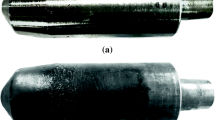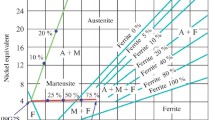Abstract
The failure analysis on the premature wear of a “Laying Head Pipe” in a Wire Rod Mill has been presented. The hot-rolled wire rods subsequent to finish rolling pass through the “Laying Head Pipe” which rotates and lays the wire rods in the form of coils for air cooling to achieve the final properties. A worn-out pipe and a thermo-mechanically treated (TMT) re-bar have been analyzed. The material of the pipe is ASTM A335-P5 grade of seamless alloy steel pipe used for high temperature service. The microstructures of the wear groove of the alloy steel pipe show predominantly ferrite and globular cementite/carbide particles along with scales, while that away from the wear groove shows coarse tempered martensite matrix. EDS analysis confirms the presence of alloy carbides near the wear groove. Microhardness profile shows reduction in hardness toward the inner surface of pipe; hardness at the inner surface of the pipe becomes lower than the surface hardness of the TMT re-bar, exhibiting tempered martensite matrix. Softening at the inner surface of the pipe wall occurs due to a rise in temperature/ over-tempering in contact with the passing hot wire rods (900 °C) which causes transformation of martensite into ferrite and coarse globular cementite.










Similar content being viewed by others
References
IS 228: Part 20: Methods for Chemical Analysis of Steels—Part 20: Determination of Carbon and Sulphur by Infra Red Absorption Method. Bureau of Indian Standard, New Delhi (2003)
ASTM A 335/A 335M-11: Standard Specification for Seamless Ferritic Alloy-Steel Pipe for High-Temperature Service. ASTM International, West Conshohocken
Indian Standard 1786: 2008 High Strength Deformed Steel Bars and Wires for Concrete Reinforcement—Specification. Bureau of Indian Standards, New Delhi
Wagner, C.: Types of reaction in the oxidation of alloys. Z. Elektrochem. 63, 772 (1959)
Stott, F.H., Wood, G.C.: Internal oxidation. Mater. Sci. Technol. 4, 1072 (1988)
Kusano, A., Misumi, H., Harada, S.: The mechanism of the internal oxidation layer along the surface crack on the slab. Tetsu-to-Hagané 81, 52 (1995)
Krauss, G.: Microstructures, Processing, and Properties of Steels, ASM Hand Book, vol. 1, 10th ed., p. 135. ASM International, Materials Park (1997)
Krauss, G.: Tempering and structural change in ferrous martensites. In: Marder, A.R., Goldstein, J.I. (eds.) Phase Transformations in Ferrous Alloys. The Metallurgical Society, Warrendale (1984)
M. Wisti, M. Hingwe: Tempering of steel, ASM Hand Book, Heat Treating, vol. 4, p. 121. ASM International, Materials Park (1991)
Author information
Authors and Affiliations
Corresponding author
Rights and permissions
About this article
Cite this article
Mukhopadhyay, G., Bhattacharyya, S. Wear of Laying Head Pipes in a Wire Rod Mill. J Fail. Anal. and Preven. 13, 474–482 (2013). https://doi.org/10.1007/s11668-013-9701-6
Received:
Revised:
Published:
Issue Date:
DOI: https://doi.org/10.1007/s11668-013-9701-6




